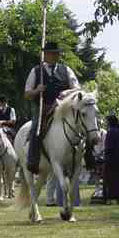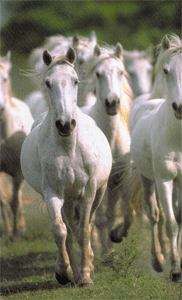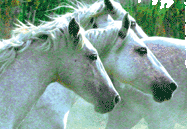
 As
the name suggests, these horses come from the
Camargue, a wetland area at the mouth of the River
Rhône. They constitute a distinct breed, which, like the Camargue bulls,
live in semi-liberty. The Camargue horse is one of the oldest breeds in the world,
closely related to the prehistoric horses whose remains have been found elsewhere
in southern France. At birth they are coloured dark brown or black, but turn white
around the fourth year (In layman's terms they are white horses, but to horsy
folk they are grey, since they are not uniformly pure white all over).
As
the name suggests, these horses come from the
Camargue, a wetland area at the mouth of the River
Rhône. They constitute a distinct breed, which, like the Camargue bulls,
live in semi-liberty. The Camargue horse is one of the oldest breeds in the world,
closely related to the prehistoric horses whose remains have been found elsewhere
in southern France. At birth they are coloured dark brown or black, but turn white
around the fourth year (In layman's terms they are white horses, but to horsy
folk they are grey, since they are not uniformly pure white all over).

 Like
the Camargue
bulls, they are smaller than their modern cousins. At
around thirteen or fourteen hands they are technically ponies.
They are used in rounding up Camargue bulls. They are never
stabled, but well able to survive the humid summer heat
and the biting winter cold.
Like
the Camargue
bulls, they are smaller than their modern cousins. At
around thirteen or fourteen hands they are technically ponies.
They are used in rounding up Camargue bulls. They are never
stabled, but well able to survive the humid summer heat
and the biting winter cold.



 Riders
are called gardians. Gardians are as near to anyone comes
nowadays to living the cowboy way of life. They play a major
role in guarding Camarguais traditions. They live in traditional
cabanes, thatched and windowless single-storey structures
furnished with bulls' horns over the door to ward off evil
spirits. A guardien's traditional tools are a trident and
a black hat.
Riders
are called gardians. Gardians are as near to anyone comes
nowadays to living the cowboy way of life. They play a major
role in guarding Camarguais traditions. They live in traditional
cabanes, thatched and windowless single-storey structures
furnished with bulls' horns over the door to ward off evil
spirits. A guardien's traditional tools are a trident and
a black hat.

 The
Camargue is a rugged horse that breeds true to type. They
are lively but have a good natureand are particularly suited
for riding. They have an even-temper but are lively, agile,
brave and hardy. They will travel long distances with ease
and are capable of enduring extreme weather and extended
periods without food. Their broad hooves are evolutionary
adaptions to their wet environment. Camargues are not shod.
The
Camargue is a rugged horse that breeds true to type. They
are lively but have a good natureand are particularly suited
for riding. They have an even-temper but are lively, agile,
brave and hardy. They will travel long distances with ease
and are capable of enduring extreme weather and extended
periods without food. Their broad hooves are evolutionary
adaptions to their wet environment. Camargues are not shod.

 Camarges
are used to manage the bull herds. They also provide visitors
with the opportunity to explore the Camargue
region on horseback. Camargue horses thrive in Sea water
- they are often called "the horse of the sea"
.
Camarges
are used to manage the bull herds. They also provide visitors
with the opportunity to explore the Camargue
region on horseback. Camargue horses thrive in Sea water
- they are often called "the horse of the sea"
.
These horses represent one of the oldest breeds in the
world. They are bred in an area bounded by Montpellier to
the west, Tarascon to the north and Fos to the east, passing
through Salon-de-Provence, an area which encompasses the
"Ile de Camargue ", the plains of the Gard
and the Hérault,
and part of the Crau.



 The
breed has existed in the area since prehistoric times. Its
origins are shrouded in mystery. It may be descended from
the extinct Soutré horse, whose bones (datinf from
17,000 years ago) have been found in the southeast of France.
Horse images in Paleolithic cave paintings at Lascaux provide
further evidence of Prehistoric horses in south-western
France. Many peoples have settled in the Camargue,
including the Celts,
Greeks,
Phoenicians,
Romans,
Visigoths,
Moors,
and Franks.
The horses brought with these peoples may well have influenced
the Camargue breed over time. Today the breed is strictly
protected.
The
breed has existed in the area since prehistoric times. Its
origins are shrouded in mystery. It may be descended from
the extinct Soutré horse, whose bones (datinf from
17,000 years ago) have been found in the southeast of France.
Horse images in Paleolithic cave paintings at Lascaux provide
further evidence of Prehistoric horses in south-western
France. Many peoples have settled in the Camargue,
including the Celts,
Greeks,
Phoenicians,
Romans,
Visigoths,
Moors,
and Franks.
The horses brought with these peoples may well have influenced
the Camargue breed over time. Today the breed is strictly
protected.

 Like
most horses (but not all!), the the Camargue horse is a
herbivore. The teeth are adapted for eating grasses and
herbs: incisors tear the plants and premolars behind the
incisors chew them. In spring the Camargue horse grazes
on new shoots of tall reeds, and on an indigenous plant
called samphire. In winter they survive on dried grass and
goosefoot, a plant too tough for most grazing animals. The
horses' behaviour is regulated by the amount of food available.
When it is scarce the Camargue horse may graze for up to
22 hours a day. When it is plentiful, it will graze only
at dawn and dusk.
Like
most horses (but not all!), the the Camargue horse is a
herbivore. The teeth are adapted for eating grasses and
herbs: incisors tear the plants and premolars behind the
incisors chew them. In spring the Camargue horse grazes
on new shoots of tall reeds, and on an indigenous plant
called samphire. In winter they survive on dried grass and
goosefoot, a plant too tough for most grazing animals. The
horses' behaviour is regulated by the amount of food available.
When it is scarce the Camargue horse may graze for up to
22 hours a day. When it is plentiful, it will graze only
at dawn and dusk.
Horses of the Camargue
run wild - or at least semi-wild - in small herds consisting
of one stallion, his mares and progeny. Fillies are usually
caught and branded as yearlings and colts considered unsuitable
for breeding are gelded at three years old. Breeding is
semi-wild but under supervision of the Biological Research
Station of la Tour du Valat. Scientists have been able to
observe the social interactions and lifestyles of Camargue
horses contributing to our understanding of equine behaviour.
Camargue horses are gereraly born either black or brown,
but turn grey with maturity at around 4 years. An adult
stands between 13 - 14 hands.

 Conformation:
Conformation:
Association des Eleveurs de Chevaux de Race Camargue
Mas du Pont de Roustry,
13 200 Arles, France
Tel: +33 (0) 4 90 97 86 32,
Fax: +33 (0) 4 90 97
70 82
Height: 13-14.2 hands
Sexual Maturity: Female, 18 months. Male, 1-2 years.
Mating: Late spring
Gestation:11-13 Months
No. of young: 1.
Habit: Sociable; living in small, free-ranging herds, mainly
in salt-water marshland like the Camargue
Diet: Ground vegetation: leafy grasses, herbs, and plants.
Call: Ranges from a soft whinny to a shrill piercing cry.
Lifespan: 20-25 years.

 As
the name suggests, these horses come from the
Camargue, a wetland area at the mouth of the River
Rhône. They constitute a distinct breed, which, like the Camargue bulls,
live in semi-liberty. The Camargue horse is one of the oldest breeds in the world,
closely related to the prehistoric horses whose remains have been found elsewhere
in southern France. At birth they are coloured dark brown or black, but turn white
around the fourth year (In layman's terms they are white horses, but to horsy
folk they are grey, since they are not uniformly pure white all over).
As
the name suggests, these horses come from the
Camargue, a wetland area at the mouth of the River
Rhône. They constitute a distinct breed, which, like the Camargue bulls,
live in semi-liberty. The Camargue horse is one of the oldest breeds in the world,
closely related to the prehistoric horses whose remains have been found elsewhere
in southern France. At birth they are coloured dark brown or black, but turn white
around the fourth year (In layman's terms they are white horses, but to horsy
folk they are grey, since they are not uniformly pure white all over).
 Like
the Camargue
bulls, they are smaller than their modern cousins. At
around thirteen or fourteen hands they are technically ponies.
They are used in rounding up Camargue bulls. They are never
stabled, but well able to survive the humid summer heat
and the biting winter cold.
Like
the Camargue
bulls, they are smaller than their modern cousins. At
around thirteen or fourteen hands they are technically ponies.
They are used in rounding up Camargue bulls. They are never
stabled, but well able to survive the humid summer heat
and the biting winter cold.
![]()

 Riders
are called gardians. Gardians are as near to anyone comes
nowadays to living the cowboy way of life. They play a major
role in guarding Camarguais traditions. They live in traditional
cabanes, thatched and windowless single-storey structures
furnished with bulls' horns over the door to ward off evil
spirits. A guardien's traditional tools are a trident and
a black hat.
Riders
are called gardians. Gardians are as near to anyone comes
nowadays to living the cowboy way of life. They play a major
role in guarding Camarguais traditions. They live in traditional
cabanes, thatched and windowless single-storey structures
furnished with bulls' horns over the door to ward off evil
spirits. A guardien's traditional tools are a trident and
a black hat. 










